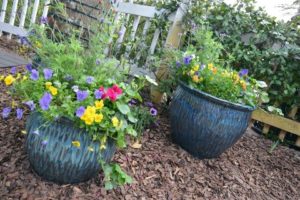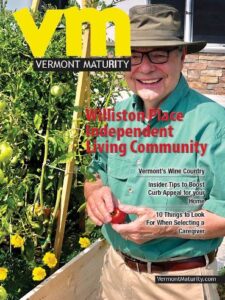
With the mercury buried at 17 below on a late February morning, David LaDuke stood looking through the glass of a horticulture greenhouse attached to his Jericho home. Mesmerized by the swirling patterns of frost feathers, he fought the urge to raise his hand to the glass and leave a print.
“It’s so beautiful, you don’t want it to end,” LaDuke said.
But for all of winter’s beauty, gardeners do very much want it to end. The growing season in Vermont is notoriously short; locals joke that a year in the Green Mountain State consists of “ski season, mud season and the Fourth of July.”
That abbreviated growing season has given rise to a thriving sub-industry within gardening, based on keeping open as long as possible the window of time for plants to thrive – or even survive. From simple row covers to elaborate greenhouses, a wide range of helping hands are available to anyone with a green thumb.
“It’s all about extending the season,” said LaDuke, owner of New England Greenhouse Structures in Jericho. “Our summers are so short, but I believe that with the right mindset you can have a longer growing season on both ends.”
Row Covers & Cold Frames
No one knows that race against time better than farmers. Rob Rock of Pitchfork Farms in Burlington’s Intervale considers it “gambling” when trying to beat spring out of the starting gate and outlast winter at the finish line.
“You’re hoping to beat the elements, but there’s a limit; it’s some skill and a lot of luck,” said Rock, whose 16-acre, organic vegetable farm provides produce to a number of area restaurants and stores. “But if you can use your ingenuity and get an extra three or four weeks in either direction, it can make a big difference.”
Rock said the simplest tools for stretching the season are row covers. Typically fashioned from a woven material such as burlap or fabric, row covers work best when “floated” over plants rather than resting directly on them. Anchoring the edges with soil prevents the covers from blowing away.
“It’s like putting a blanket over your crop,” Rock said. “If you use little hoops to keep it up, it can make a big difference on cold nights and give you an extra month from the first frost date. You can keep kale going until Christmas.”
The next step up would be cold frames, a sort of miniature greenhouse typically constructed using recycled windows. The functionality of opening and closing the windows allows the grower to condition plants to changing temperatures, a method that works particularly well with sensitive crops such as tomatoes and eggplants.
“We’ve used cold frames in the spring, to harden off transplants that were started in a greenhouse,” Rock said. “We started onions from seed while there was still snow on the ground, and if we had planted those straight into the ground in April they would have struggled.
“The cold frames help toughen them up, and it makes a big difference.”
Container Gardening
The ability to start plants indoors is important to season extension, and the key to doing so is container gardening. Also an ideal choice for those with limited space and sunlight, container gardening affords strict control over otherwise natural elements that are important to the growth cycle of a seedling.
“Container gardening allows you to get a jump on the season, because you can use warm soil right away,” said Betsy Combs of Gardener’s Supply in Williston. “Usually, you have to wait for the ground to thaw, not just at surface level but several feet down, below frost level.”
Artificial, full-spectrum light sources can also be used to help bolster plant health and growth. The containers themselves can range from commercially available pots to just about any receptacle one can imagine.
“Almost anything can be used as a container – including an old shoe,” Combs said with a laugh.
One of the major benefits of container gardening is that plants can be easily moved from one location to another, to take advantage of certain elements. “I like to put plants in my driveway, because it absorbs heat and warms them up,” Combs said. “If there is concern of frost, I can pull them into my garage overnight without needing to cover them.”
The container approach is a natural fit with garden planning as well. Combs said Gardener’s Supply offers a document listing optimum start dates for various vegetable, herb and flower seeds, allowing growers to formulate a strategy for starting their crops.
“You figure out what you want to plant and work backward,” Combs said. “It makes gardening not seem so overwhelming. It can be intimidating, but it’s really not hard.”
Greenhouses
Those whose ambitions – and plants – outgrow container gardening can venture beyond, into the nearly endless possibilities afforded by a greenhouse.
From simple hoop-and-polypropylene covers to full-fledged aluminum-and-glass structures, greenhouses take the concept of a controllable growing environment and expand it.
“It’s all about the user’s space, and what they need,” said LaDuke, who has built more than 400 greenhouses during his 29 years in the business. He added that gardeners are often creative thinkers, which makes for an enjoyable process designing a greenhouse together.
“I like to work with interesting individuals,” LaDuke said. “People who want a garden and enjoy having their hands in the dirt are often neat people to talk to.”
The blank-canvas nature of the process – LaDuke custom builds each structure – usually leads to a one-of-a-kind product, despite the fact that ready-made greenhouses can effectively be purchased right off the shelf.
“I don’t remember the last time I sold a kit out of a catalog,” LaDuke said. Whereas many gardeners view a greenhouse strictly from a viewpoint of functionality, others – particularly those interested in attaching the structure to their homes – see an opportunity to add a dynamic new living space.
“It allows them to go out there in their robe and slippers, and have their morning coffee out there with the flowers,” LaDuke said. “And it doubles as a passive, solar heat source; they can open the door, and the heat from the greenhouse will move into the house and can easily heat two or three rooms.”
With the help of a greenhouse, a gardener can effectively have a growing season that stretches from late March into November – a far cry from what Mother Nature affords. It also creates an environment that LaDuke believes can help relieve the mental monotony of a long, cold Vermont winter.
“As we age, it becomes more of an issue to stay inside,” LaDuke said. “A greenhouse can make winter shorter, at least when it comes to your mindset.”
As well as your taste buds, according to the farmer, Rock. “Having fresh spinach to eat at Thanksgiving is a pretty neat trick,” Rock said.
Adam White contributed this article.
 Related Articles & Free Subscription
Related Articles & Free Subscription
Expand Your Edible Garden Indoors




Comment here